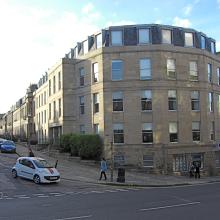
In Issue 188 we touched on some of the once familiar church landmarks which have now vanished from Broughton's streets. By following the links below, you can find photos of them.
To start, here is a modern view of the Albany/Broughton Street junction, taken from Forth Street. If you now look again at the photo of Alexander 'Greek' Thomson's St Vincent Street Church in Glasgow (Issue 188, p. 3), you can see roughly how his unsuccessful competition entry would have fitted into Broughton's topography.
Follow this link to find photos of the successful design for St Mary's Free Church which eventually became Barony and St James' Church, again on the corner of Albany and Broughton Streets.[img_assist|nid=1244|title=|desc=|link=node|align=right|width=150|height=200]
All that survives is the former manse (right).
The position of the church's predecessor on Barony Street can be seen in the map at the foot of this page, a detail from the 1852 Ordnance Survey. It stands opposite the Glasite Meeting House.
*****
Following Elizabeth Fraser's Letter of 13 October, we have been looking high and low for photographs of New Broughton. The closest we've found so far are of Paterson's Court at the end of Barony Street (click on them to magnify).
Industrious local historian Alice Lauder found the first black-and-white picture below in the Evening Dispatch of 1 September 1938. It shows the property in the process of being taken down. An earlier image taken when the building was still inhabited (c.1928) is available here.
Opposite Paterson's Court, across a narrow lane, stood the unusual building shown in the second black-and white image below. Behind it looms one of the New Broughton tenements.This picture is another discovery of Alice Lauder, found in the City Library's Edinburgh Room and dating perhaps from c.1912.
The original lay-out of Old Broughton is also apparent from the 1852 Ordnance Survey. Paterson's Court stood at the west end of Barony Street, and New Broughton had not yet been built. James Nasmyth's 1830s smithy (Issue 183, p. 3) may have been situated on the south side of Broughton Market, or, more likely, slightly further north in what is marked as the Broughton Foundry.
[img_assist|nid=1245|title=|desc=|link=node|align=left|width=200|height=157]
[img_assist|nid=1241|title=|desc=|link=node|align=left|width=200|height=136]
[img_assist|nid=1242|title=|desc=|link=node|align=center|width=640|height=460]